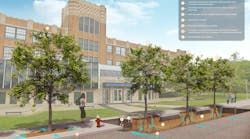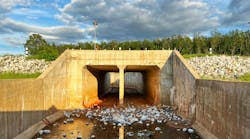C-PACE provides incentives to implement stormwater management resiliency measures
Extreme weather and commercial infrastructure are increasingly at odds as economic development continues in areas threatened by climate impacts. The frequency and intensity of extreme weather events such as hurricanes, floods, and wildfires have increased over the past decade due to climate change. According to the National Oceanic and Atmospheric Administration (NOAA), the U.S. experienced 28 separate billion-dollar weather and climate disasters in 2023 alone, resulting in significant economic damage to infrastructure and commercial properties.
Additionally, commercial properties are subject to a growing number of mandates for green infrastructure upgrades set by state and local legislatures. For example, New York City’s recently implemented Local Law 97 requires buildings over 25,000 square feet to meet rigid carbon emission limits starting in 2024, with steep penalties for non-compliance. Similarly, California’s Title 24 building energy efficiency standards have steadily increased requirements for sustainable infrastructure in commercial properties.
Property owners and developers, already facing rising capital, material, and labor costs, must determine how to pay for effective resiliency measures. The alternative is to face fines, heightened insurance premiums, and/or potentially costly damage from extreme weather events. A report by Federal Emergency Management Agency (FEMA) found that commercial buildings in states with the 10 highest expected annual loss totals based on their exposure to natural hazards have seen a 31% increase in insurance costs year over year and a 108% increase from five years ago.1
C-PACE impacts
Commercial Property-Assessed Clean Energy (C-PACE) financing offers a cost-effective solution by providing low-cost capital for new construction and renovations, with the latter including improvements such as stormwater best management practices (BMPs) like green roofs, permeable pavements, and bioretention systems. Studies by the U.S. Department of Energy highlight that these green infrastructure solutions significantly reduce stormwater runoff, mitigating flood risks and enhancing urban resilience.
C-PACE is a public-private partnership that delivers private, low-cost capital to finance sustainability and resiliency upgrades for both new and existing commercial buildings. The PACE financing mechanism utilizes private capital that is secured through a tax assessment placed on the property by the local taxing authority. This structure enables long-term financing (up to 30 years) with fixed-rate terms, making it more accessible for property owners. Because the funding is structured as a property tax assessment rather than a traditional loan, it is treated as an operating expense (OPEX), improving project economics and easing repayment. This also allows developers to allocate their capital to other projects while ensuring compliance with evolving building codes and regulations.
With increasing risks from stormwater damage, wildfires, and other climate-related threats, state and local governments are turning to C-PACE to provide commercial real estate investors with access to the low-cost capital needed to upgrade infrastructure without slowing down the development of multifamily housing and commercial buildings. C-PACE financing can offer terms of up to 30 years, is non-recourse, and can improve the property’s cash flow by also financing measures that reduce utility costs.
Mixed-use development project in Connecticut
CounterpointeSRE recently financed over $63 million for the new construction of the Corbin District, a mixed-use development in Darien, Connecticut. This project, which received the 2024 C-PACE Outstanding Project of the Year award, incorporates 20,000 square feet of porous asphalt and permeable pavers to manage approximately 652,000 gallons of stormwater annually, which is particularly useful in a region that experiences an average of 51 inches of rainfall per year.
In addition to its BMPs, the project includes energy-efficient upgrades to HVAC systems, building envelope, lighting, EV charging stations, and low-flow water fixtures, with modeled utility savings of $2.1 million over 25 years. These sustainable measures contribute to the project’s carbon reduction goals, estimated at 266.09 metric tons of CO2 equivalent (MTCO2e) of avoided emissions in the first year alone. As the first project in Connecticut to fund stormwater management measures through C-PACE, it serves as a model for integrating resiliency measures while maintaining, and even increasing, a developer's returns.
Other notable examples of stormwater BMPs financed through Counterpointe’s C-PACE program include the retrofit of 1111 Bellevue Street in Detroit, Michigan, which features a green roof, blue roof, and rain garden.
Green roofs, covered with vegetation, provide significant runoff control by capturing, temporarily retaining, and infiltrating rainwater, reducing peak flows and total stormwater discharge. The blue roof complements this system by collecting and temporarily storing runoff, mimicking natural water retention and percolation. Meanwhile, the rain garden functions similarly to the green roof but at ground level. This project manages approximately 57,500 gallons of stormwater, saves 66,500 kWh in energy, and reduces CO₂ emissions by 53 metric tons each year.
As cities and states grapple with rising material and labor costs alongside growing climate risks, C-PACE has emerged as a win-win mechanism that lowers carrying costs, increases resiliency and sustainability, and bolsters a property’s appeal to tenants. The financing structure not only makes green upgrades financially viable but also supports broader economic development goals by enabling sustainable growth without imposing undue financial burdens on developers and property owners.
References
- Federal Emergency Management Agency, “Expected annual loss,” accessed May 2024.
About the Author
Victor Zhang
Victor Zang is an associate at C-PACE.


